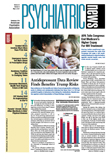Whether personal psychotherapy should be a part of every psychiatry resident's training was a subject for considerable discussion at the annual meeting of the American Association of Directors of Psychiatric Residency Training (AADPRT) in San Juan, Puerto Rico, in March.
The training directors largely agreed that therapy was valuable for residents as a tool of personal growth and professional development, but they also acknowledged that it was no longer as common as in the years when they were residents.
Several noted that barriers to entering personal psychotherapy for today's residents—in addition to those of personal resistance—include time, cost, and stigma. Some training directors also expressed the tension between recommending personal psychotherapy as an educational tool versus using it as a treatment.
David Mintz, M.D., training director at the Austen Riggs Center in Massachusetts, described the extensive logistical and financial support the center provides its trainees to pursue personal psychoanalytical psychotherapy as part of training to become a psychotherapist.
“We view this as a valuable learning experience,” he said.“ If you start to tell residents they should seek out psychotherapy only when they are experiencing an emotional crisis, right there you are introducing stigma. It suggests to the resident that he or she is a problem resident and that there is something wrong with him or her.”
Others, however, expressed wariness about the value of psychotherapy as a tool for personal growth. Instead, residents should be encouraged to seek psychotherapy when they are experiencing a diagnosable mental condition, they suggested.
Still others, including Jennifer Haak, M.D., now an attending psychiatrist at the University at Buffalo, said that residency is an unusually stressful passage and that it would be rare for a trainee to go through it without experiencing any emotional and mental distress.
Mintz, in the same vein, noted that trainees at the Austen Riggs Center typically treat very difficult patients with personality disorders. He said that work with such patients can be extremely taxing on the treating therapist, and as a result residents often require psychotherapy for their own mental health, he said.
Haak presented her research on attitudes among residents toward personal psychotherapy, for which she received the 2007 Frieda Fromm-Reichmann Award, which was presented during the AADPRT meeting.
Haak randomly contacted 36 training programs and requested via e-mail resident contact information, and 25 programs responded.
The residents were then contacted three times—by e-mail or regular mail—and phone contact was made with chief residents at each program. Out of 396 residents contacted, 107 responded (58 women, 49 men).
The survey found that 32 percent of residents who responded are in personal psychotherapy, and 42 percent had previously been in therapy.
Affiliation with a psychoanalytic institute and being further along in training were positively correlated with being in psychotherapy.
The most common form of therapy for those currently in treatment was psychodynamic psychotherapy (58.8 percent), followed by supportive psychotherapy (17.6 percent), and “other” (11.8 percent). The forms of therapy least likely to be used by the residents were psychoanalysis (5.9 percent) and cognitive-behavioral therapy (2.9 percent).
Residents were also asked to rate barriers to participating in psychotherapy, with the two highest-rated obstacles being time constraints and money.
The others, in order, were family considerations and demands, fear of negative perceptions by faculty, limited number of therapists available, training programs discouraging psychotherapy, fear of negative perceptions by fellow residents, and family values and beliefs.
In an interview with Psychiatric News following the AADPRT meeting, Haak said she undertook the study with the strong belief that psychotherapy was vital for anyone seeking to be a psychiatrist. After completion of the survey, and the discussion at the AADPRT meeting, she was less certain that it is a necessity for every trainee.
“But I think this is a huge issue in terms of the tradition of psychiatry residency training and one that needs more discussion and consideration,” she said.
“No matter what psychiatrists are doing, whether it's medication management or a phone call or in the framework of traditional psychotherapy, we interact with our patients and have to understand the dynamics of the relationship and the things that we and our patients bring to the table.”
Paul Mohl, M.D., vice chair of education and the residency training director at the University of Texas Southwestern Medical School, offered a coda to the discussion, stating that psychotherapy was invaluable to teaching residents how to listen to patients—but that for anyone who was really going to engage in therapy as a patient, it could never be solely an educational exercise.
“I don't think there is any such thing as a training analysis or psychotherapy,” he said. He recalled his own analysis during residency when he told the analyst as it was ending, “I could never have done this solely for the sake of my training.”
Yet Mohl believes there is a “chasm” between where most residents are in their ability to listen to patients at the beginning of their training and where they should be at the end of training. And personal psychotherapy is one of the best ways to carry residents from one point to the other, he said.
“On one side of the chasm, you can be a very benevolent, very benign, very helpful, thoughtful, and supportive psychiatrist,” he said.“ And on the other side of the chasm, you never listen to a patient quite the same way again. That's why I think personal psychotherapy is so important.” ▪
